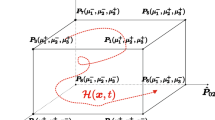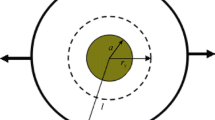Abstract
In this paper, the effect of particle geometry on Young’s modulus for particulate-reinforced composites was estimated using finite elements analysis (FEA) and modified Halpin–Tsai (HT) equations, including not only the effect of the aspect ratio but also the particle shape. This modified HT model includes a new parameter (a) which depends on the angle of the particle corners. FEA was used as a starting point to find the composites behavior depending on the reinforcement features, results that were compared to experimental values. Young’s moduli and stresses distribution were estimated using an AlA356/SiC(p) composite as starting material . Selected particle geometries for modeling were cylinders, truncated cylinders, double cones, and double-truncated cones; while aspect ratios were modified from 0.6 to 1.8. There was an excellent agreement between experimental results, FEA, and modified Halpin–Tsai estimations, showing that the predicting ability of the Halpin–Tsai model could be improved by introducing different shape parameters.






Similar content being viewed by others
References
Engineered Materials Handbook. Volume 1: Composites (1989). ASM International, Metals Park, Ohio
Manna A, Bains HS, Mahapatra PB (2010) Experimental study on fabrication of Al–Al2O3/Grp metal matrix composites. J Compos Mater 45:2003–2010
Everett RK, Arsenault RJ (eds) (1991) Metal matrix composites: processing and interface. Academic Press, New York
Wilson S, Ball A (1990) Tribology of composite material. ASM International, Metals Park, Ohio
Rafiee M, He XQ, Mareishi S, Liew KM (2014) Modeling and stress analysis of smart CNTs/fiber/polymer multiscale composite plates. Int J Appl Mech 6(3):23
Hashin Z, Rosen BW (1964) The elastic moduli of fiber-reinforced materials. J Appl Mech 31(2):223–232. doi:10.1115/1.3629590
Feng S, Cui X, Li G (2014) Thermo-mechanical analyses of composite structures using face-based smoothed finite element method. Int J Appl Mech 6(2):17
Aghdam MM, Smith DJ, Pavier MJ (2000) Finite element micromechanical modelling of yield and collapse behaviour of metal matrix composites. J Mech Phys Solids 48:499–528
Halpin JC, Tsai SW (1967) Environmental factors in composite materials design. Air Force Materials Laboratory, TR 67-423
Wu Y, Jia Q, Sheng D, Zhang L (2004) Modeling Young’s modulus of rubber–clay nanocomposites using composite theories. Polym Test 23(8):903–909
Cook RD, Malkus DS, Plesha ME (1989) Concepts and applications of finite element analysis, 3rd edn. Wiley, New York
Ganesh VV, Chawla N (2005) Effect of particle orientation anisotropy on the tensile behavior of metal matrix composites: experiments and microstructure-based simulation. Mater Sci Eng A 391:342–353
Kari S, Berger H, Gabbert U (2007) Numerical evaluation of effective material properties of randomly distributed short cylindrical fibre composites. Comput Mater Sci 39:198–204
Liu YJ, Chen XL (2003) Continuum models of carbon nanotube-based composites using the boundary element method. Electron J Boundary Elem 1:316–335
Pahlavanpour M, Moussaddy HH, Ghossein E, Hubert P, Levesque M (2013) Prediction of elastic properties in polymer–clay nanocomposites: analytical homogenization methods and 3D finite element modeling. Comput Mater Sci 79:206–215
Alfonso I, Figueroa IA, Sierra JM, Abatal M, Gonzalez G, Rodriguez-Iglesias V, Medina-Flores A, Flores JE (2013) Young’s modulus estimation based on high symmetry 3-D finite element model for metal matrix composites. Comput Mater Sci 69:304–310
Karevan M, Pucha RV, Bhuiyan MdA, Kalaitzidoul K (2010) Effect of interphase modulus and nanofiller agglomeration on the tensile modulus of graphite nanoplatelets and carbon nanotube reinforced polypropylene nanocomposites. Carbon Lett 11:325–331
Huang Y, Jin KK, Ha SK (2008) Effects of fiber arrangement on mechanical behavior of unidirectional composites. J Compos Mater 42:1851–1871
Jung HK, Cheong YM, Ryu HJ, Hong SH (1999) Analysis of anisotropy in elastic constants of SiCp/2124 Al metal matrix composites. Scripta Mater 41:1261–1267
McLean A, Soda H, Xia Q, Pramanick AK, Ohno A, Motoyasu G, Shimizu T, Gedeon SA, North T (1997) SiC particulate-reinforced aluminium-matrix composite rods and wires produced by a new continuous casting route. Compos Part A 28:153–162
Gurrum SP, Zhao J, Edwards DR (2011) Inclusion interaction and effective material properties in a particle-filled composite material system. J Mater Sci 46(1):101–107. doi:10.1007/s10853-010-4844-2
Engineered Materials Handbook. Volume 2: Properties and Selection: Nonferrous Alloys and Special-Purpose Materials (1990) ASM International, Metals Park, Ohio
Chawla N, Shen Y (2001) Mechanical behavior of particle reinforced metal matrix composites. Adv Eng Mater 3:357–370
Chawla N, Chawla KK (2006) Microstructure-based modeling of the deformation behavior of particle reinforced metal matrix composites. J Mater Sci 41:913–925
Srivastava VK, Gabbert U (2011) Analysis of particles loaded fiber composites for the evaluation of effective material properties with the variation of shape and size. Int J Eng Sci Technol 3:52–68
Acknowledgments
The authors would like to acknowledge the financial support from SENER–CONACYT 151496 and UNAM PAPIIT TA100114 for funding the project.
Author information
Authors and Affiliations
Corresponding author
Additional information
Technical editor: Eduardo Alberto Fancello.
Rights and permissions
About this article
Cite this article
Alfonso, I., Figueroa, I.A., Rodriguez-Iglesias, V. et al. Estimation of elastic moduli of particulate-reinforced composites using finite element and modified Halpin–Tsai models. J Braz. Soc. Mech. Sci. Eng. 38, 1317–1324 (2016). https://doi.org/10.1007/s40430-015-0429-y
Received:
Accepted:
Published:
Issue Date:
DOI: https://doi.org/10.1007/s40430-015-0429-y




